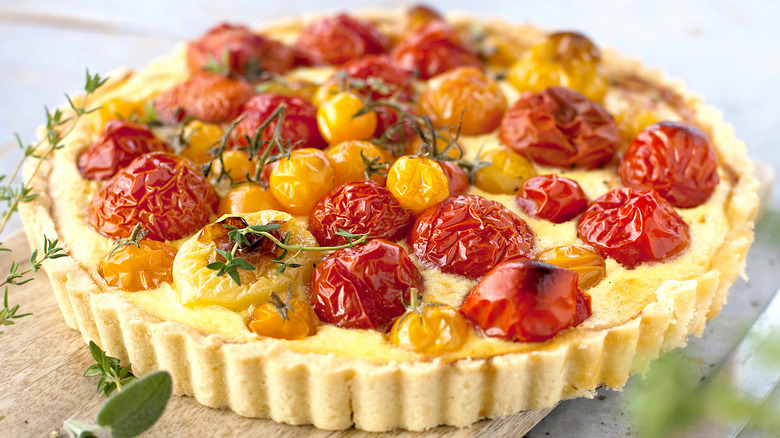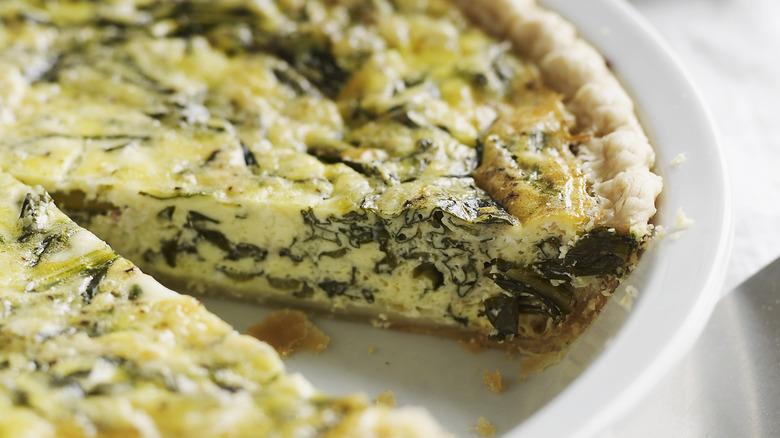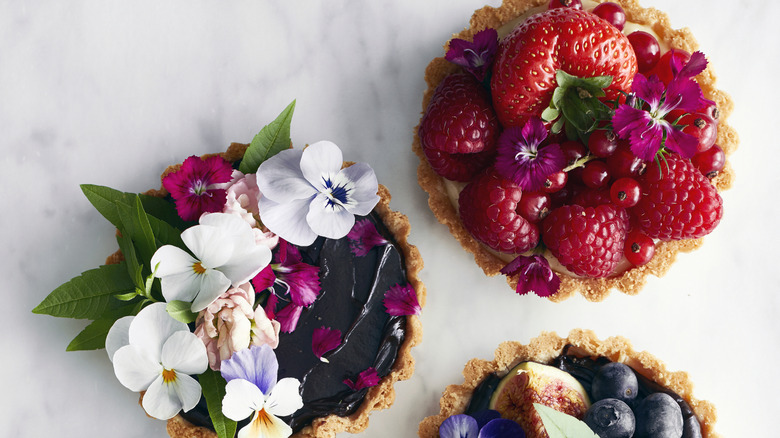Quiche Vs. Tart: What's The Difference?
There's an ongoing debate in the culinary world regarding the difference between tarts and quiches. I've been told by a friend who is a professional baker that a quiche is actually a very specific French tart, while someone else I know wholeheartedly believes that quiches don't belong in the tart category at all. Admittedly, there are a lot of similarities between the two, but after contemplating the deep stuff in life, like I so often do, I arrived at a conclusion: Even though both quiches and tarts involve a crust and a variety of delicious fillings, they're fundamentally different dishes.
Quiches are what you go to when you're looking for hearty, custard-based delights. They're stacked to the brim with savory ingredients and never go into sweet territory. Tarts are sleeker, more versatile, scrumptious creations that can be either savory or sweet. Why does it matter anyway if they're sometimes hard to distinguish but both delicious in their own right? Well, if you're hosting brunch, whipping up dinner, or creating a show-stopping dessert, knowing the differences between a quiche and a tart will help you choose the right dish for the occasion.
Quiche is the custard-centric comfort food
The defining characteristic of a quiche is its rich, creamy custard filling made of eggs and heavy cream. This custard is poured into a shortcrust pastry and baked until set, creating a hearty dish that's perfect for brunch, lunch, or even a light dinner. Unlike tarts, quiche is almost always made with a buttery, flaky pie crust that holds up well against the wet custard filling. The pastry is typically partially blind-baked before adding the filling to prevent a soggy bottom and ensure a crisp and structured base.
One of the best things about quiche is its versatility with savory ingredients. You can easily fill it with bacon, ham, spinach, mushrooms, cheese, and more to create endless variations. One of the most famous quiche recipes — quiche Lorraine — combines eggs, cream, cheese, and smoky bacon for a rich and comforting flavor.
Some quiches are baked in standard pie dishes, but they're usually deep-dish. However, it's worth noting that quiche can sometimes be made in shallower forms, depending on the recipe. The crust provides a delicate crunch, while the custard filling remains soft and tender but firm enough to hold its shape when sliced.
Even though quiche has a luxurious, creamy texture, the balance of crust, eggs, and mix-ins keeps it from feeling too heavy. If you're looking for a filling and savory dish, quiche is a comfort food favorite that pairs beautifully with a light salad or roasted vegetables.
Tarts are sleek and stylish pastries
In contrast, tarts have a crisp, thin crust and a wide range of potential fillings. Unlike quiche, tarts can be made with shortcrust, puff pastry, graham cracker, wafer, or even shortbread crusts. This makes them incredibly versatile, as their texture can vary from flaky and buttery to crumbly and crunchy. While shortcrust is common for savory tarts, dessert tarts often use crumb-based crusts for a sweeter, more delicate bite.
Tarts are usually shallower than quiches, though there are exceptions. Many classic French tarts, such as tarte tatin, are noticeably thin, while some tarts may be slightly deeper. However, tarts don't typically have the same custard-heavy filling as quiches, which is why they are often considered the lighter option.
Savory tarts are especially elegant, often featuring prettily arranged ingredients like caramelized onions, goat cheese, or asparagus. The fillings sit on top of or within the crust rather than being fully encased in a filling, giving them a refined, open-faced presentation. Sweet tarts, on the other hand, showcase everything from fresh fruit and pastry cream to rich chocolate ganache. Because they have a delicate crust, dessert tarts feel lighter, even when topped with indulgent ingredients. The crust is usually fully-blind baked before adding a pre-cooked or fresh filling.
Understanding the differences in crust, depth, and filling will help you decide which dish best suits your needs. Or, better yet, experiment with both. No matter which you choose, you'll end up with a delicious result that can be as simple or as fancy as you like.


